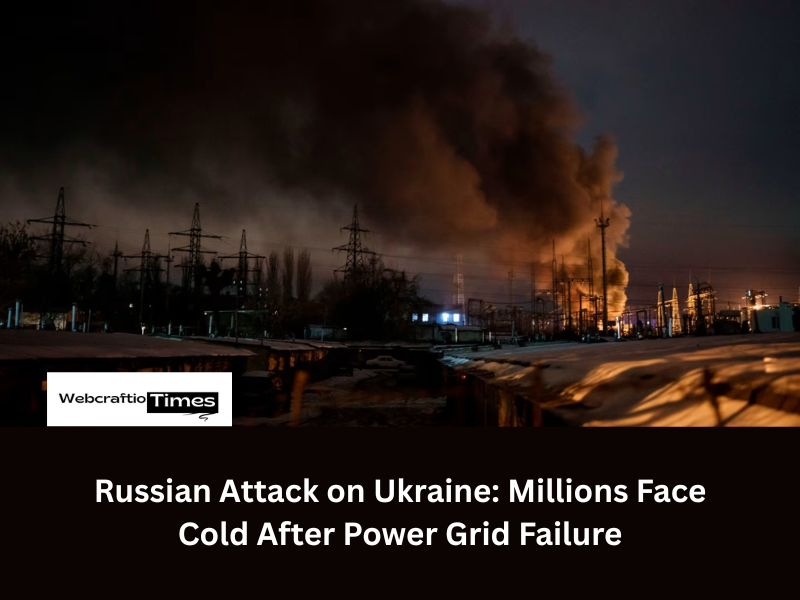A massive new military assault recently targeted Ukraine’s critical infrastructure. This Russian attack on Ukraine has plunged millions into darkness. It represents the largest strike on the nation’s power grid since the war began. The coordinated missile and drone strikes aimed to destroy energy-generating facilities nationwide. Analysts see this Russian attack on Ukraine as a calculated strategy before winter. The sudden loss of power creates a deadly situation as temperatures fall. Ukraine’s energy system is now under intense pressure. This latest Russian attack on Ukraine creates a genuine energy crisis. It affects nearly every major city.
I. The Scale of Destruction: Tracking the Russian Attack on Ukraine
Power plants in the Kyiv and Kharkiv regions suffered catastrophic damage. Ukraine’s state power company confirmed generating capacity dropped to zero there. Officials reported hundreds of drones and dozens of missiles used in the coordinated assault. This strategic Russian attack on Ukraine targeted essential energy substations. It also hit gas facilities vital for heating. The strikes impacted substations that supply nuclear power plants. Damage assessment teams worked quickly to survey the destruction. They face immense challenges in making swift repairs.
Read More: Putin May Resume Russia’s Nuclear Testing In Response to the US
This persistent Russian attack on Ukraine aims to shatter national morale. International observers condemned the scope of the infrastructure damage. The sheer volume of munitions used defines a new conflict phase. The ongoing Russian attack on Ukraine shows a brutal focus on civilian support systems. Rebuilding the damaged facilities will take months and vast resources. This single Russian attack on Ukraine highlights the grid’s vulnerability.
II. Zero Capacity: Impact on Infrastructure
The recent strikes severely damaged Ukraine’s power generation facilities. This included thermal power plants and crucial hydroelectric dams. Infrastructure experts confirm a catastrophic loss of capacity. Power companies now scramble to implement emergency protocols. Engineers initiated rolling blackouts nationwide immediately after the bombardment. These scheduled outages last many hours in most regions. The widespread damage threatens the stability of the entire national grid. Repair crews work tirelessly under difficult conditions. They prioritize temporary fixes for immediate stabilization. The true cost of the latest Russian attack on Ukraine is unknown.
Replacing large transformers and key components will take many months. Many required parts are not readily available internationally. This Russian attack on Ukraine strategically targeted high-voltage substations. These points manage the flow of electricity across the country. Destroying them isolates large regions from available power. Furthermore, the Russian attack on Ukraine targeted gas storage and distribution networks. This complicates efforts to provide home heating fuel. The deliberate focus on energy infrastructure shows a clear military aim. The government urges citizens to conserve all available resources now. This repeated Russian attack on Ukraine aims to make the country uninhabitable this winter. Russian attack on Ukraine also creates a huge demand for international reconstruction aid.
III. The Immediate Humanitarian Crisis
The sudden loss of heat and light creates an urgent humanitarian crisis. Millions of Ukrainian families now face extremely cold conditions. Doctors worry about treating patients without consistent power supply. Hospitals rely on noisy, limited-capacity generators for critical functions. Emergency medical services struggle to navigate dark streets for calls. Schools and businesses must close their doors immediately. This wide-scale disruption paralyzes local economies across the country. Humanitarian organizations are mobilizing resources now. They quickly rush blankets, warm clothing, and thermal shelters to affected areas. The brutal Russian attack on Ukraine deliberately targets civilian well-being.

People line up for hours to fill containers with drinking water. Water pumping stations rely heavily on stable electricity. The devastating Russian attack on Ukraine also impacts access to basic communications. Charging phones and accessing news becomes increasingly difficult for residents. This strategic Russian attack on Ukraine increases the dependency on external aid. Governments must provide emergency lighting and heating equipment. The long-term impact of the constant Russian attack on Ukraine on mental health is severe. The international community must quickly condemn this strategy. The latest Russian attack on Ukraine shows a disregard for human life.
IV. A Cold Strategy: Context and Response
The timing of this large-scale assault is highly strategic. Russia launched the attacks just as temperatures began their seasonal drop. Analysts interpret the strikes as a calculated effort to increase civilian hardship. This winterization of warfare aims to force negotiations from a position of distress. The repeated Russian attack on Ukraine follows a pattern established in previous years. However, the intensity and scale of this recent assault surpass past efforts. Global leaders have quickly condemned this targeting of civilian infrastructure. They call the action a war crime under international law.
The Russian attack on Ukraine prompts renewed demands for advanced air defense systems. Patriot missile systems and other air protection are crucial now. International partners swiftly pledged emergency financial aid and equipment. They promised assistance for immediate repairs and long-term reconstruction needs. Sanctions against Russia also remain a central focus of the response. The economic pressure attempts to limit funding for further military actions. The government prepares citizens for difficult months ahead now. Ultimately, this intense Russian attack on Ukraine tests the resolve of the Ukrainian people. They continue to demonstrate immense resilience. The outcome of the war hinges partially on the success of these defensive efforts.
Russian Attack on Ukraine Conclusion
The massive scope of the recent power outages is undeniable. It showcases the brutal efficiency of a targeted energy war. The Russian attack on Ukraine presents the country with its most significant infrastructure challenge yet. Millions now endure cold and dark due to these coordinated strikes. Ukraine’s resilience and international support will determine the coming months. Repair crews work against time and harsh winter weather. The deliberate strategy of the Russian attack on Ukraine fails to break national spirit. This article highlights the severe cost of war on civilian life. The international response must now accelerate support efforts. The world watches Ukraine face this terrible Russian attack on Ukraine with courage.
Q: What makes this recent attack the largest of the war?A: It is the largest strike since the war began and reduced power generating capacity to zero in key regions (like Kyiv and Kharkiv) for the first time.Q: What is the primary humanitarian consequence?A: Millions face extremely cold conditions and darkness due to immediate, long-lasting rolling blackouts and compromised heating fuel access before winter.Q: Which specific energy facilities did Russia target?A: Russia strategically targeted thermal power plants, hydroelectric dams, high-voltage substations, and gas distribution networks across multiple regions.Q: What is the strategic goal behind the timing of the attacks?A: Analysts call it a “cold strategy” designed to increase civilian suffering during winter to pressure the government and potentially force negotiations.Q: How is the international community helping Ukraine respond?A: Partners are pledging emergency financial aid, reconstruction assistance, and providing advanced air defense systems like Patriot missile systems.



